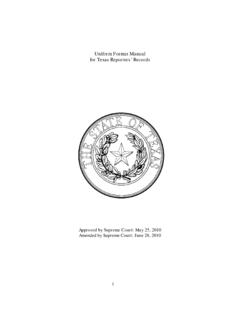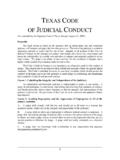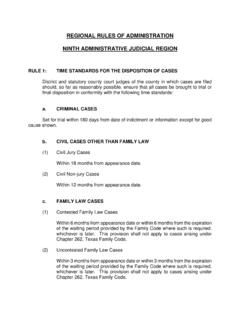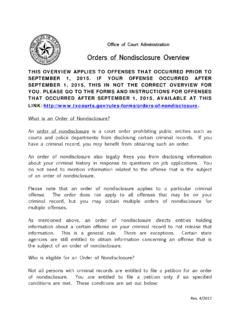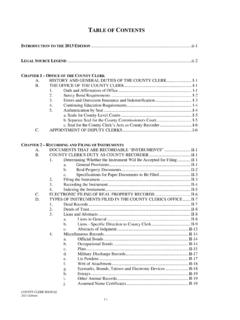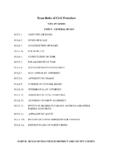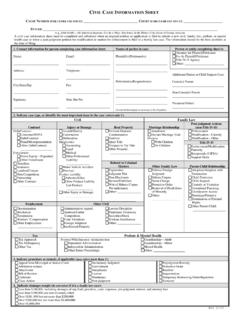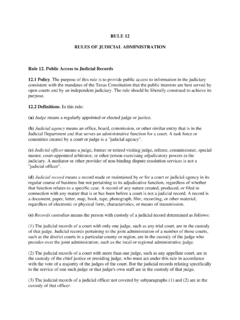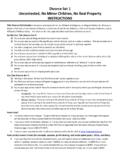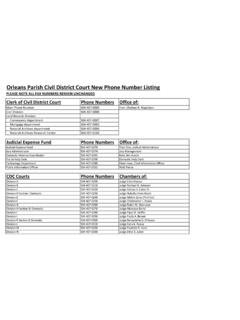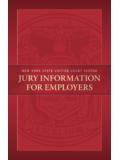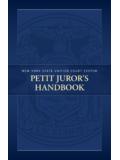Transcription of TECHNOLOGY STANDARDS - txcourts.gov
1 TECHNOLOGY STANDARDS JUDICIAL COMMITTEE ON INFORMATION TECHNOLOGY Version Released: October 20, 2017 TECHNOLOGY STANDARDS Judicial Committee on Information TECHNOLOGY Page 2 of 24 1 INTRODUCTION PURPOSE Pursuant to Texas Government Code, Chapter 77, Section , this document delineates STANDARDS for the technological needs of the judicial system. This document is approved by the Judicial Committee on Information TECHNOLOGY (JCIT) that was created by the 74th Texas Legislature. Changes to this document are effective 90 days after adoption and publication by the JCIT. VERSIONS Version Action Release Initial Draft April 11, Added Audio/Video StandardsJuly 25, Added eFiling Filing TypesNovember 12, Added additional eFiling TypesMarch 21, Added STANDARDS for AdditionalServices; RemovedDigital Signature standard (covered in rules).
2 Various changes to other STANDARDS October 14, Small changes to codes per county feedbackFebruary 20, Small changes to codes per county feedbackAugust 14, Changes to return for correction reasons, additional services January 29, Addition of JP civil and criminal standardsAdditional codes in district/county criminal Addition of standard filer processes August 26, Small changes per feedbackJanuary 20, Small changes per feedbackOctober 20, DEFINITIONS Attachment any unique supporting document including exhibits and proposed orders that are not defined in Rule 21 (a) of the Texas Rules of Civil Procedure. Digital Media any files stored in an electronic format. This can include (but is not limited to) text, audio and video files.
3 Document a pleading, plea, motion, application, request, exhibit, brief, memorandum of law, or other instrument in electronic form. DPI Dots per inch Lead Document a document as defined by Rule 21 (a) of the Texas Rules of Civil Procedure. If filing a single document, it is the lead document. NARA National Archives and Records Administration NIEM National Information Exchange Model a partnership of the Department of Justice, the Department of Homeland Security, and the Department of Health and Human Services designed to develop, disseminate and support enterprise wide information exchange STANDARDS and processes that can enable jurisdictions to effectively share critical information in emergency situations, as well as support the day to day operations of agencies TECHNOLOGY STANDARDS Judicial Committee on Information TECHNOLOGY Page 3 of 24 throughout the nation.
4 NIEM was adopted formally by JCIT and is promulgated in data exchanges in Texas Administrative Code, Title 1, Part 8, Chapter 177. Electronic Court Filing (ECF) STANDARDS a set of non proprietary extensible markup language (XML) and Web services specifications, along with clarifying explanations and amendments to those specifications that have been added for the purpose of promoting interoperability among electronic court filing vendors and systems. OCA Office of Court Administration OCR Optical Character Recognition PDF Portable Document Format for the purpose of these STANDARDS this is PDF (ISO 19005 1:2005 Revised as ISP/NP 19005 1). This standard specifies how to use PDF for long term preservation of electronic documents and is applicable to documents containing combinations of character, raster and vector data.
5 PDF Distiller a program or application that converts files into PDF files so that the printed appearance of a document is preserved regardless of the application used to create it. This functionality is commonly seen as Print to PDF , Save to PDF or Export to PDF . PDF Software software that conforms to International Organization for Standardization (ISO) 32000 1:2008. This standard specifies STANDARDS for creating (writing), reading, displaying and interacting with PDF documents. JCIT Judicial Committee on Information TECHNOLOGY REFERENCES NIEM OASIS LegalXML Electronic Court Filing (ECF) specifications courtfiling/ VLC media player supported formats Windows media player supported formats 2 SYSTEM DATA EXCHANGE STANDARDS In accordance with Texas Administrative Code, Title 1, Part 8, Chapter 177, information exchanges that occur between the various systems (electronic filing manager, case management, document management, etc.)
6 Should occur using the current OASIS LegalXML specifications. The OASIS LegalXML specification is a subset to NIEM. 3 DIGITAL MEDIA STANDARDS In addition to content and formatting promulgated by the Texas Rules of Civil Procedure, Texas Code of Criminal Procedure, and Texas Rules of Appellate Procedure, the following STANDARDS apply to digital media filed electronically or scanned from source records (filed after the effective date of these STANDARDS ) by the clerk. DOCUMENTS TECHNOLOGY STANDARDS Judicial Committee on Information TECHNOLOGY Page 4 of 24 A. An e filed document must be in text searchable PDF, using fonts specified in the PDF specification, on page size, with the content appropriately rotated.
7 B. When possible, the document should be generated directly from the originating software using a PDF distiller. C. Prior to being filed electronically, a scanned document must have a resolution of 300 DPI. Preferably, scanned documents should be made searchable using OCR TECHNOLOGY . D. An e filed document may not contain any security or feature restrictions including password protection or encryption and may not contain embedded multi media video, audio, or programming. E. Documents may not contain package PDF s. PDF s should not be embedded inside of another PDF. Documents may not contain embedded fonts. Each document must be a single PDF. An appellate court may require that multiple PDF documents be combined into a single PDF document and bookmarks used to separate content appropriately.
8 The content of the document should not depend on bookmarks. F. Any e filed document filename should contain only alphanumeric characters that are part of the Latin1_General character set. No special characters are allowed and the length of the filename should be restricted to 50 characters. AUDIO/VIDEO A. The following media players are supported (specific audio/video formats can be found on each media player s website): a. VLC media player (VideoLAN Organization) b. Windows media player (Microsoft) B. When an audio/video file is natively supported by at least one media player listed in these STANDARDS , the file must not be converted into another format. C. If an audio/video file is not natively supported by at least one media player listed in these STANDARDS , the file must be converted to another format supported by at least one media player listed.
9 The original, any hardware requirements, and software needed to view/hear the original must be submitted as well. D. If modifications are needed to enhance the native audio/video, a copy of the original must be made. The modified copy (submitted in addition to the original audio/video) must also be generated in a format supported by at least one media player listed in these STANDARDS . TECHNOLOGY STANDARDS Judicial Committee on Information TECHNOLOGY Page 5 of 24 4 EFILING FILING CONFIGURATIONS Below are the standard filing configurations to be used in the eFiling system for district, county court at law, probate, constitutional county, and justice of the peace courts. This list of filing configurations must be accepted in each court.
10 Courts and clerks may not add to this configuration, but may eliminate codes if not needed in a particular jurisdiction. It is important to note that these STANDARDS only apply to the electronic filing system which is a delivery system and are NOT STANDARDS for a county case management or document management system. CIVIL CASES DISTRICT AND COUNTY COURTS CASE CATEGORIES/TYPES Case Category CodeCase Type Codes Civil Contract Debt/Contract Consumer/DTPA Debt/Contract Debt/Contract Debt/Contract Fraud/MisrepresentationDebt/Contract OtherForeclosure Home Equity ExpeditedForeclosure OtherFranchiseInsuranceLandlord/TenantNo n CompetitionPartnershipOther ContractCivil Employment DiscriminationRetaliationTerminationWork ers Compensation Other EmploymentCivil Injury or Damage Assault/BatteryConstructionDefamationMal practice Accounting Malpractice LegalMalpractice MedicalMalpractice Other Professional LiabilityMotor Vehicle AccidentPremisesProduct Liability Asbestos/Silica Product Liability Other
